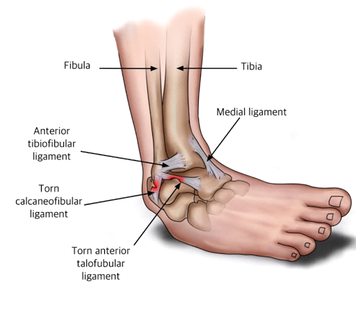 Ankle sprains are a very common injury. There's a good chance are that you yourself have had an ankle sprain or two in your life as well. They occur more often with sports like basketball, netball and soccer but they can happen to anyone at anytime. So what are ankle sprains and why are they so common? What are ankle sprains? A sprain injury essentially means that you tear the ligament/s that hold the bones of a joint together. Ligaments protect joints by giving them stability during movement. So in an ankle sprain, one or more of the ligaments protecting the ankle are torn. A sprain injury essentially means that you tear the ligament/s that hold the bones of a joint together. Ligaments protect joints by giving them stability during movement. So in an ankle sprain, one or more of the ligaments protecting the ankle are torn. Most people when they think of an ankle sprain think of twisting or rolling the ankle inwards. This is the most common method of spraining the ankle, however it is not the only method. The ankle can also roll or twist outwards and people can sprain the medial or inside of their ankle. When we roll the ankle inwards through inversion, we sprain the ligaments on the outside of the ankle. If we roll the ankle outwards through eversion, we can sprain the ligaments on the inside of the ankle. The most commonly torn ligament is on the outside of the ankle, known as the ATFL (Anterior talofibular ligament). What to do for an ankle sprain When you sprain your ankle, there will usually be some amount of swelling and possibly bruising around the side of the ankle you have sprained. The area will be tender to touch and moving the ankle will feel stiff and sore. The swelling usually begins to subside after 2-3 days but can last for over a week. Initially after the sprain it helps to apply compression through taping the ankle, which will also give it some stability. Despite the ankle feeling stiff and sore, it is important to start weightbearing and walking on it as soon as you can. This will help to mobilise your ankle joint sooner which will help to speed up the recovery. Complete rest of the ankle initially is not recommended to assist in recovery. The most important part of recovery following an ankle sprain is treating it with specific ankle exercises as part of rehab. Following the injury muscles around the ankle are usually injured as well or weakened due to decreased use and swelling. Thus it is important to strenthen your ankle through exercises. The biggest part of ankle rehab is training your proprioception, which a term that refers to the joint's awareness of the position of the body. By training your proprioception through balance and stability exercises, you will help to increase your ankle stability and minimise the reccurence of any ankle sprains in the future. Do I need to get a scan Not every sprained ankle requires a scan like an x-ray or ultrasound to diagnose if you have torn the ligaments or broken any bones. Ankle sprains can be very painful and so naturally people think of wanting to scan for any broken bones or severely torn ligaments, however a physical examination and history taking from your physiotherapist will give you a diagnosis for most ankle sprains. Your physiotherapist will also be able to determine if you need to be sent off for scans if necessary. 5 Things to Know About Ankle Sprain 1) They're common! 2) They can occur on the outside and also inside of your ankle 3) You don't need to have an ultrasound or x-ray scan to diagnose your ankle sprain 4) Early weightbearing and walking is more important than rest following an ankle sprain 5) Exercises help you achieve the best recovery - specifically proprioception exercises! |
AuthorWrite something about yourself. No need to be fancy, just an overview. Archives
April 2024
Categories |
|
|
|


 RSS Feed
RSS Feed









